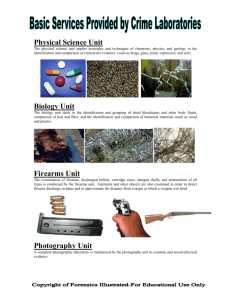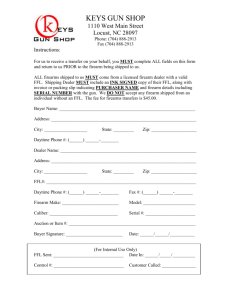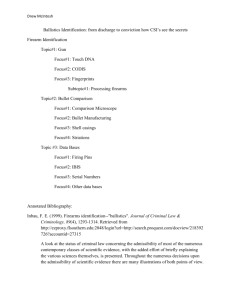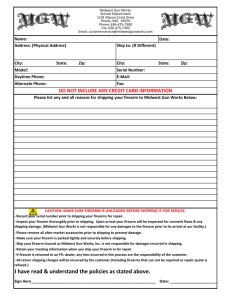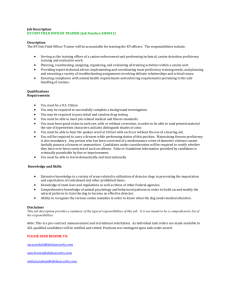UTAH CONCEAL CARRY - edgetraininggroup
advertisement
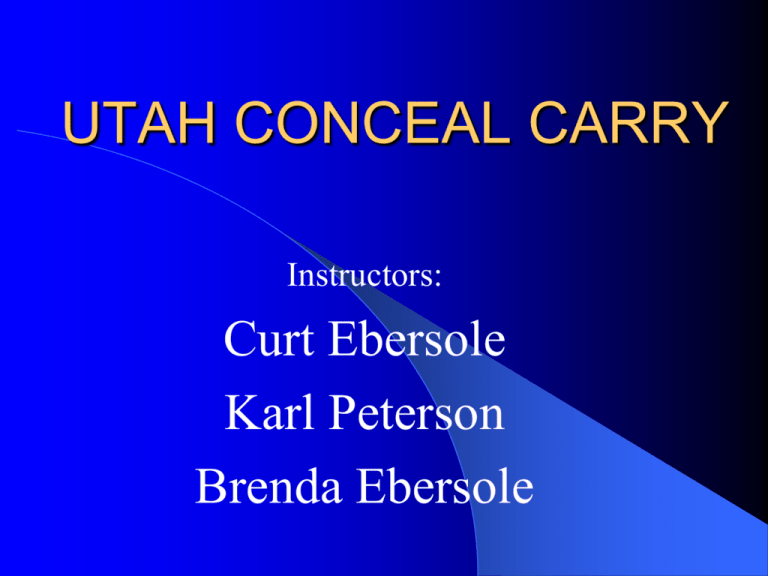
UTAH CONCEAL CARRY Instructors: Curt Ebersole Karl Peterson Brenda Ebersole Let’s pass out the packets. Utah-30+ states FAQ Application Student Outline Statutory Guidelines Applicants must complete familiarity instruction with firearms. Understand safe loading, unloading, storage, and carrying of a concealed weapon. Understand current laws regarding CCW * Handgun Safety Rules What is the primary cause of firearm related accidents? IGNORANCE CARELESSNESS * ELEMENTS OF FIREARM SAFETY Positive Attitude Knowledge Skill * FOUR BASIC GUN SAFETY RULES 1. 2. 3. 4. Treat all firearms as if they are loaded Always keep your finger off the trigger until your sights are on target and you have made the decision to fire. Never point a firearm at anything you are not willing to destroy. Before the decision to fire, be sure of your target, your target’s environment and any other safey hazards. * OTHER SAFETY/RANGE RULES 1. 2. 3. 4. 5. 6. 7. 8. 9. Know your target and what is beyond. Know how to use the firearm safely. Be sure the firearm is safe to operate. Use only the correct ammunition Wear eye and ear protection NEVER use alcohol or drugs Store all firearms so they are not accessible to unauthorized persons, i.e. children, restricted persons, etc. Never handle a handgun in an emotional state such as anger Keep the firearm unloaded until ready for use. * OTHER SAFETY CONSIDERATIONS 1. 2. 3. 4. 5. Be a knowledgeable gun handler and user. Before starting to clean a gun, be certain is it not loaded. Cleaning a gun also provides an opportunity to check the proper function of the gun. Always be sure the barrel is free of obstructions. When handing a pistol to another person, always be sure that the muzzle is pointed in a safe direction, your finger is off the trigger, the action is open, magazine has been removed and the chamber is empty. * OTHER SAFETY CONSIDERATIONS Carry only one type of ammo to avoid mixing different types. If in possesion of an old or antique firearm, or gun that is a military souvenir, be sure that it is unloaded. Never fire at surfaces that can cause a bullet to ricochet, such as water, or hard flat surfaces. If a cartridge fails to fire when the trigger is pulled, keep the muzzle pointed in a safe direction; don’t attempt to open the action to remove the cartridge for at least 30 seconds. * OTHER SAFETY CONSIDERATIONS If anything unusual is noticed when a shot is fired, such as a difference in recoil or in noise, immediately do the following: 1. Stop firing immediately. 2. Keep the muzzle pointed in a safe direction. 3. Keep your finger off the trigger. 4. Unload the gun and check to be sure the chamber is empty; and 5. Visually inspect the barrel for obstructions. * PERMIT HOLDERS ARE RESPONSIBLE FOR TEACHING THEIR CHILDREN AND OTHER OCCUPANTS IN THEIR HOME ABOUT FIREARM SAFETY * Responsibility The permit holder should be a positive role model for their children. Children should be taught the difference between television, toys and real life. Children should be taught what to do if they come across a firearm without an adult present: 1. 2. 3. 4. Stop Don’t Touch Leave the area Tell a responsible adult * HANDGUN PARTS AND OPERATION Revolver and Semi Auto FRAME: The frame of the revolver and semiautomatic is the backbone to which all other parts are attached. 1. GRIP PANELS-Grip portion of the grip frame. 2. BACKSTRAP-Rear vertical portion of frame. 3. TRIGGER GUARD-Trigger protection to reduce unintentional firing. 4. SIGHTS-Front and rear sights used for aiming * HANDGUN PARTS AND OPERATION Revolver and Semi Auto BARREL: The barrel is a metal tube through which a bullet passes on its way to the target. BORE-Inside the barrel. RIFLINGS-Combination of lands and grooves which adds flight stability. CALIBER-The distance between the lands. * HANDGUN PARTS AND OPERATION ACTION-Group of moving parts used to load, fire and unload the pistol (Revolver/Auto) REVOLVER: 1. TRIGGER-When the trigger is pulled, it activates the hammer which in turn causes the firing pin to strike and fire the cartridge. 2. CYLINDER-Holds cartridges in individual chambers arranged in a circular pattern. Each time the hammer moves to the rear, the cylinder turns and brings a new chamber to line with the barrel and firing pin. 3. CYLINDER RELEASE LATCH-Releases the cylinder and allows it to swing out so that cartriges can be loaded and unloaded. 4. TWO TYPES OF REVOLVER ACTIONS Single Action-Trigger performs only one action, releases the hammer, firing the pistol Double Action-Trigger performs two tasks. Cocks and releases the hammer, firing the pistol. * HANDGUN PARTS AND OPERATION ACTION-Semi Automatics 1. SLIDE-Upon intial loading of all semi-automatics, the first cartridge must always be manually cycled into the firing chamber by retracting the slide and then releasing it. As the slide returns to the closed position, it removes a cartridge from the top of the magazine and inserts in into the chamber. 2. MAGAZINE-The magazine is a storage device designed to hold cartridges ready for insertion into the chamber. 3. MAGAZINE RELEASE-A device that releases the magazine so that it can be removed from the pistol. 4. TRIGGER-When the trigger is pulled, it activates the hammer (or internal firing mechanism) which when released, causes the firing pin to strike and fire the cartridge. The slide moves to the rear ejecting the empty cartridge case and usually cocking the pistol in the process. The cartridges in the magazine are forced upward by the magazine spring into the path of the slide. When the slide moves forward, it picks up and pushes the top cartridge into the chamber. * THERE ARE THREE TYPES OF AUTOMATICS: SINGLE Action-1911-The trigger performs a single task, releasing the external hammer or the internal firing device so that the firing pin hits the cartridge. DOUBLE/SINGLE Action-Beretta-The trigger performs two tasks, It cocks the external hammer for the first shot, and also releases the external hammer. After the first shot is fired the movement of the slide on ejection of the spent cartridge will cock the external hammer. With these mechanisms cocked, all successive shots will be single action. DOUBLE ACTION only-Glock-The trigger will cock and release the external hammer or internal firing mechanism on the first shot and successive shots. * DEMONSTRATIONS OF THE FOLLOWING: How to check both revolvers and semi-autos to ensure proper function of the firing mechanism and safety. Explanation and demonstration of safe loading, cocking, uncocking, and unloading procedures for both revolvers and semi automatics. Familiarize yourself with the owner’s manual. Know and be familiar with cylinder rotation direction of revolvers….especially yours. * AMMUNITION TYPES OF CARTRIDGES CENTER-FIRE 2. RIM FIRE 1. * AMMUNITION COMPONENTS OF CARTRIDGES CASE-Metal cylinder (usually made of brass) that is closed on one end and contains other components such as a primer, powder and bullet. PRIMER-An impact sensitive chemical compound used for ignition. Rimfire-The primer is contained in the inside rim of the case’s base. Centerfire-The primer is contained in a small metal cup and is located in the center of the case’s base. POWDER CHARGE-A fast burning chemical compound used as a propellant and is contained inside the body of the case. BULLET-A projectile, usually made of lead and sometimes covered with a layer of copper or other metal, and is located at the mouth of the case. WAD (Shotgun Only)-Plastic cup inside a shotgun cartridge used to contain the shot or projectile for use in a shotgun. * 1. 2. CARTRIDGE FIRING SEQUENCE 1. 2. 3. 4. Pulling the trigger of the pistol will cause the firing pin to hit and ignite the primer. The flame generated by the primer ignites the powder in the cartridge. The powder burns very rapidly and produces a high volume of gas. These expanding gases push the bullet out of the cartridge case and propel it out of the pistol barrel at a high rate of speed 800-4000 FPS. * Ammo Safety Guidelines Inspect ammunition for safety flaws and imperfections. Understand range capabilities of ammunition. 1. 2. Remember rule #4-Be sure of your target and behind it. Discussion about dangerous capabilities of pistol ammo. Be sure to use the proper caliber ammunition with the gun to be fired. 1. 2. 3. 380 vs 9mm 38 vs 357 magnum 45 long colt vs 410 shotgun * Ammo Safety Guidelines cont’d Defensive Ammunition Reliability-The ability of a firearm to consistently chamber, fire, extract and eject a particular load without malfunctions. Controllability-The ability to fire multiple rounds and still manage recoil and maintain accuracy. Stopping Power-The ability of a cartridge to quickly incapacitate An assailant or otherwise cause an assailant to stop his attack. Accuracy-Ability of the gun and ammunition combination to shoot to the point of aim indicated by the sights. Muzzle Flash-When in excess will impair night vision and illuminate your position. Hollow-points-They open up and expand upon impact. This more efficently transfers energy and also prevents over penetration or complete penetration that could endanger the lives of others. * LET’S TALK ABOUT PRACTICE AMMO Non-expanding-Typical full metal jacket. Involves greater penetration. Reduced powder charge-More manageable recoil. Reduced cost- * Care and Storage of Ammunition . Always keep ammunition in factory box or container that can be properly labeled. Store ammunition in a cool dry place free from extreme temperature variations. Store ammunition separately from guns and not accessible from unauthorized persons, especially children Never submerge in water or expose to any solvents, petroleum products, bore cleaner, amonia or other chemicals. Chemicals can penetrate the cartridge and cause the primer or the powder to deteriorate. Explanation of the importance of rotating defensive ammunition stored for long periods of time in your handgun. * AMMUNITION MALFUNCTIONS Misfire-Failure of the cartridge to fire after the primer has been struck by the firing pin Hangfire- A perceptible delay in the ignition of a cartridge after the primer has been struck by the firing pin. Squib load-Development of less than normal pressure or velocity after ignition of the cartridge. Unusual difference in recoil or noise. ** DEALING WITH MALFUNCTIONS Misfire-Hangfire: Keep the pistol pointed in a safe direction-a hangfire might exist and the cartridge could still fire. Don’t attmept to open the action of the pistol to remove the cartridge for at least 30 seconds Squib load:Keep the muzzle pointed in a safe direction, wait 30 seconds and then unload gun. Check to make sure the chamber is empty and the barrel free of obstructions. * Fundamentals of Handgun Shooting There are three primary two handed shooting stances: Isosceles Stance Weaver Stance Modified Isosceles Stance Two Handed Shooting Stances Isosceles Stance- This position is so named because in this position your extended arms when seen from above resemble an isosceles triangle. Feet are placed shoulder width apart. Feet and shoulders are square to the target. Knees are slightly bent with weight slightly forward on the balls of the feet. Two-handed grip of the gun with the arms extended forward and the elbows slightly bent. The head is erect, not hunched and shoulders are at normal height. The firearm is lifted to the level of the eyes for aiming This is a more instinctive and natural position for most shooters. * ….more stances Weaver Stance- Named for former San Diego County Sheriff Jack Weaver. Feet are positioned in a boxer stance with the strong foot rearward. The weak shoulder is angled toward the target. The knees are flexed and the body weight is carried slightly forward, on the balls of the feet. The elbows are bent downward to bring the gun closer to the body than the isosceles. The head is tipped slightly to view the sights. An isometric action is employed between the stong and weak arm for stability. The recoil is absorbed through the bent elbows and the isometric pushing and pulling between the strong and support hand. * ….more stances Modified Isosceles Stance: This position incorporates the natural, fully-extended arm position of the isosceles position with the stability of the asymmetrical boxer’s stance foot placemnt of the Weaver position. Allows better recoil absorbtion. The head is level and the body leans forward. * GET A GRIP HAND GRIP-Operate firearm repeatedly without changing grip. BODY POSITION-Least amount of body and firearm movement. BREATH CONTROL-Control breathing to minimize body and firearm movement. SIGHT ALIGNMENT-The relationship of the eye in alignment with the rear and front sight. TRIGGER SQUEEZE-The ability to apply increasing pressure on the trigger and allow the hammer to fall without disturbing the sight picture. FOLLOW THROUGH-Stabilizing recoil, maintaining grip and stance, regaining front sight focus, resetting the trigger and preparing for follow up shot if a threat persists. * Rules to follow…On the Range Always fully comply with the range officers instructions. Follow the 4 safety rules. 1. 2. 3. 4. Treat all firearms as if loaded Always keep finger off of trigger until you are on target and ready and you have made the decision to fire. Never point a firearm at anything you are not willing to destroy. Before the decision to fire, be sure of your target, your target’s environment and any other safety hazard. Wear eye and ear protection at all times during practice shooting. How do you hand a firearm to another person (Demonstration) Explaination and demonstate the three combat postions for a firearm: a. In the holster or case b. at the ready c. on target * Failure To Fire Faulty Ammunition-Type I malfunction-faulty ammo, mag not seated. Failure to Eject-Type II-Stovepipe, partial ejection Feedway Stoppage-Type III-Double feed, extractor gummed or broken guide rods. Extractor does not get a good grip on the spent cartridge. Chamber blocked. Failure to go to battery-Type IV-Bad chamber design. Weak guide spring. Extremely dirty guide rails or guide rod. Malfuntion Resolution: Tap, Invert, Rack, Reassess * DEMONSTRATION OF: Safe Loading Cocking Uncocking Unloading REVOLVERS VS SEMIAUTOMATICS* Maintenance and Cleaning of: Why is it important to clean and maintain? Safety considerations when cleaning…. How do you clean a revolver? How do you clean a semi-automatic? * Holsters and Holstering What is the purpose of a holster? What are the different types of holsters? Advantages and disadvantages: 1. Safety 2. Accessibility 3. Security 4. Concealment Methods of carry…. Safety is the first consideration * Safe Concealment Considerations… The firearm should be in a holster or case The firearm should be hidden from view and be placed so that it is only accessible to the individual carrying it. A handgun should not just be thrown in a glovebox, under the car seat or a drawer. The permit holder is responsible for their firearm at all times. * Safe Storage of Firearms/Ammo Firearms should be stored unloaded. (Storage is when the firearm is not available for immediate use) Recommend that firearms and ammunition are stored separately. Recommend that both are properly secured. * Storage Devices Safes 2. Locked Cases 3. Safe Proofing Devices 4. The need for safety does not end just because you do not have the firearm with you. * 1. Child Proofing Do not store firearm where it is visible. 2. Storage area is not accessible to children. 3. Educate 4. Safety, Safety, Safety. * 1. REVIEW OF ALL FEDERAL AND STATE CODES, RULES AND REGULATIONS THAT PERTAIN TO FIREARMS OR DEFINITIONS CONTAINED THEREIN….. Legal Review Utah Law: – Concealed Firearm Act 53-5-701 to 53-5-711 – Justification of Force 76-2-401 to 76-2-407 – Rules of Arrest 77-7-1, 77-7-3 – Weapons in Prohibited areas 76-8-311.1 to 76-8-311.3 – Assault and Related offenses 76-5-102,103,104 – Weapons Laws 76-10-500 to 76-10-530 Federal Law ,(18 U.S.C. Chapter 44, Section 922) – Straw Purchase – Unlawful Transport – Unlawful Transfer – Unlawful Possession – Unlawful possession at a school zone Concealed Firearm Act U.C.A. 53-5-704 (1)(a), The bureau shall issue a permit to carry a concealed firearm for lawful self defense to an applicant who is 21 years of age or older 60 days after receiving an application. Uniform Law, Weapons U.C.A. 7610-500(2) Unless specifically authorized by the Legislature by statute, a local authority or state entity may not enact or enforce any ordinance, regulation or rule pertaining to firearms. Justification of Force Justification of Force 76-2-402 – Force in defense of a person – A person must reasonably believe that force or threat of force is necessary to defend the person or a third person against another person’s imminent use of unlawful force – Force used that is intended or likely to cause death or serious bodily injury may only be used to prevent death or serious bodily injury to himself or a third person or to prevent the commission of a forcible felony. – A person does not have a duty to retreat from threatened force in a place where that person has lawfully entered or remained Justification of Force U.C.A. 76-1-601 “Serious bodily injury” means bodily injury that creates or causes serious permanent disfigurement, protracted loss or impairment of function of any bodily member or organ, or creates a substantial risk of death Justification of Force 76-2-402 (4) Forcible felonies defined – – – – – – – – – – – – – – – – Aggravated Assault Murder/Aggravated Murder Mayhem Manslaughter Kidnapping/Aggravated Kidnapping Rape Forcible Sodomy Object Rape Rape/Object Rape of a Child Sexual Abuse/Aggravated Sexual Abuse of a Child Aggravated Sexual Assault Arson Robbery Burglary Vehicle Burglary (when occupied) Any other felony offense which involves the use of force or violence against a person so as to create a substantial danger of death or serious bodily injury Justification of Force 76-2-405 – Force in defense of habitation – A person reasonably believes force is necessary to prevent or terminate unlawful entry into or attack on the habitation – Force likely to cause death or serious injury is justified only if The entry is made or attempted in a violent tumultuous manner, surreptitiously, or by stealth and he reasonably believes the entry is made or attempted for the purpose of assaulting or offering personal violence or He reasonably believes that the entry is made or attempted for the purpose of committing a felony in the habitation and the force is necessary to prevent the commission of the felony Firearms at Residence U.C.A. 76-10-511 Except for persons described in Section 76-10503, a person may have a loaded firearm at his place of residence, including any temporary residence or camp. Residence defined: An improvement to real property used or occupied as a primary or secondary residence; i.e. tent, trailer, motor home, motel room, etc. Justification of Force 76-2-406 – Force in defense of property – A person is justified in using force, other than deadly force, when he reasonably believes that force is necessary to prevent or terminate criminal interference with real or personal property Lawfully in his possession; or Lawfully in the possession of a member of his immediate family; or Belonging to a person whose property he has a legal duty to protect Justification of Force 76-2-407 Deadly force in defense of persons on real property – A person is justified in using force intended or likely to cause death or serious bodily injury against another in his defense of persons on real property other than his habitation if: He is in lawful possession of real property; He reasonably believes that the force is necessary to prevent or terminate the trespass onto real property; The trespass is made or attempted by use of force or in a violent and tumultuous manner; and The trespass is attempted or made for the purpose of committing violence against any person on real property and he reasonably believes that the force is necessary to prevent personal violence; or the person reasonably believes that the trespass is made or attempted for the purpose of committing a forcible felony that poses imminent peril of death or serious injury and that the force is necessary to prevent the commission of that forcible felony Justification of Force Considerations in determining reasonableness of force – Nature of danger – Immediacy of danger – Probability that unlawful force would result in death or serious bodily injury – Prior violent acts or propensities – Patterns of abuse or violence Unjustifiable Circumstances Initially provokes the use of force as an excuse to inflict bodily harm; Is attempting to commit, committing or fleeing after the commission or attempted commission of a felony;or Was the aggressor or was engaged in a combat by mutual agreement unless he withdraws from the attack and effectively communicates his intent to withdrawal. Arrest by Private Persons U.C.A. 77-7-3 A private person may arrest another: – For a public offense committed or attempted in his presence; or – When a felony has been committed and he has reasonable cause to believe the person arrested has committed it Arrest Defined: An arrest is an actual restraint of the person arrested or submission to custody. The person shall not be subjected to any more restraint than is necessary for his arrest and detention U.C.A. 77-7-1 Secured / Prohibited Areas Weapons in Prohibited Areas 53-5-710 A person with a CFP may not carry a firearm into the following locations: – Any secure area in which firearms are prohibited and notice posted (76-10-523.5) Courts, Law Enforcement, Correctional & Mental Health Facilities – Any airport secure area (76-10-529) – Any house of worship or private residence where dangerous weapons are prohibited (76-10-530) – Otherwise prohibited by State or Federal Law Federal Buildings, Post Offices, etc. Possession at “Federal Facility” Prohibited,18 U.S.C. 930 (a) The term “Federal Facility” means a building or part thereof owned or leased by the Federal Government, where Federal employees are regularly present for the purpose of performing their official duties Weapons in Prohibited Areas Cont. Clarification on Allowed Carry Areas Indian Reservations: Each tribe is self governing, it is necessary to contact tribal leadership to obtain permission to carry on the reservation. Exception: If a highway/interstate runs through the reservation, no permission needed as long as you remain on the highway. National Parks: Effective February 22, 2010, an individual can carry as long as the national park is located in a state where Concealed Firearms are permitted, must abide by that state’s CFP laws. National Forests: Are not parks, they are governed by the state in which they are located (hunting, etc.) Churches and Private Residence U.C.A. 76-10-530 (1) A person, including a person licensed to carry a concealed firearm, after notice has been given that firearms are prohibited, may not knowingly and intentionally: – A. transport a firearm into: A house of worship; or A private residence; or – B. While in possession of a firearm, enter or remain in: A house of worship; or A private residence Churches, Notification to the division 7610-530 (4) (a) (i) Within 30 days of giving or revoking any notice pursuant to Subsections (2)(c)(d)or (e), a church or organization operating a house of worship shall notify the division on a form and in a manner as the division shall prescribe. The division shall post on its website a list of the churches and organizations operating houses of worship who have given notice under Subsection (4) (a) (i). Churches, Notification of Prohibition 76-10530 (2) (a)-(d) a. b. c. d. e. Personal communication to the actor by the owner, lessee, or person with lawful right of possession or person with authority to act for the person or entity; Posting of signs reasonably likely to come to the attention of persons entering the house of worship or private residence; Announcement by a person with authority to act for the church or organization operating the house of worship in a regular congregational meeting; Publication in a bulletin, newsletter, worship program or similar document generally circulated or available to members of a congregation regularly meeting in a house or worship Publication in a newspaper or general circulation in the county in which the house of worship is located or the church or organization operating the house of worship has it’s principal office in this state. Church News Paper Notification Discharge of Firearm on Private Property –Liability U.C.A. 53-5a-103, A private property owner who knowingly allows a person who has a permit to carry a concealed firearm under Section 53-3-704 to bring a firearm onto the owner’s property, is not civilly or criminally liable for any damage or harm resulting from the discharge of the firearm by the permit holder while on the owner’s property. Does not apply if the property owner solicits, requests, commands, encourages, or intentionally aids in the firearms discharge. Assault and Related Offenses Assault U.C.A. 76-5-102 An attempt with unlawful force or violence, to do bodily injury to another; A threat accompanied by a show of immediate force or violence, do to bodily injury to another; or An act committed with unlawful force or violence, that causes bodily injury to another or creates a substantial risk of bodily injury to another Aggravated Assault U.C.A. 76-5-103 Intentionally causes serious bodily injury to another; or Under circumstances not amounting to serious bodily injury, uses a weapon as defined in 76-1-601 or other means or force likely to produce death or serious bodily injury. Terroristic Threats U.C.A. 76-5-107 A person commits terroristic threat if he threatens to commit any offense involving bodily injury, death, or substantial property damage, and – Acts with intent to: Place a person in fear of imminent serious bodily injury, substantial bodily injury, or death; Is no defense that the person did not attempt or was incapable of carrying out the threat. The threat may be either expressed or implied Weapons Laws, Threatening Manner Defined: 76-10-506 (1) Threatening manner does not include: The possession of a dangerous weapon, whether visible or concealed, without additional behavior which is threatening; or Informing another of the actors possession of a deadly weapon in order to prevent what the actor reasonable perceives as a possible use of unlawful force by the other and actor is not engaged in any activity described in Subsection 76-2-402(2)(a) (use of force). Weapons Laws, threatening with or using dangerous weapons in fight or quarrel, U.C.A. 76-10-506 (2) (3) Except as provided in 76-2-402 (use of force) and for persons described in 76-10-503 (Restricted Persons) Displays any dangerous weapon in an angry or threatening manner or Unlawfully uses a dangerous weapon in a fight or quarrel This section does not apply to a person who, reasonably believes the action to be necessary in compliance with Section 76-2-402 (Use of force) with purpose to prevent another’s use of unlawful force: – Threatens the use of a dangerous weapon; or – Draws or exhibits a dangerous weapon Weapons Laws Uniform Law, Weapons U.C.A. 76-10-500 Except as specifically provided by state law, a citizen of the United States or a lawfully admitted alien shall not be: – Prohibited from owning, possessing, purchasing, selling, transferring, transporting, or keeping any firearm in his place of residence, property, business, or in any vehicle lawfully in his possession or lawfully under his control; or – Required to have a permit or license to purchase, own, possess, transport, or keep a firearm. Open Carry Other Applicable Criminal Statutes The right to open carry is not absolute. Illegal to draw or exhibit a dangerous weapon in an angry or threatening manner or in a fight or quarrel, except in necessary self defense (76-10-506) Illegal to possess a deadly weapon with intent to assault (76-10-507) Cannot create or contribute to a nuisance, defined as any condition dangerous to human life. (76-10-801) Carrying Loaded Firearm in Vehicle or on Street (76-10-505) A person may carry a loaded and concealed firearm in a vehicle if: – The person is 18 years old – Is in lawful possession of the vehicle – Other occupant has consent from the person in lawful control – Allowance extends to handguns only A person may carry on a public street if: – The person has a concealed firearm permit – A person without a CFP must carry in plain view and statutorily unloaded At your earliest opportunity, take time to read over the exact details of the new law Motor Vehicle Defined 41-6a-102 (34) Means a vehicle which is self propelled and every vehicle which is propelled by electric power obtained from overhead trolley wires, but not operated upon rails. Effective October 1, 2008. Firearms in a Vehicle Cont. Chapter 45 Protection of Activities in Private Vehicles Legal for people to have firearms stored in their locked vehicles parked on private property Exceptions: An employer can provide alternative parking at no cost to the employee Provide a secured and monitored storage location where the individual may securely store a firearm before proceeding with the vehicle on to the property U.C.A. 34-45-107 Exemptions to Private Parking Lots School Premises: * Are exempt from this chapter Government Entities: * Including local and state entity Religious Organizations: * Acting as an employer are exempt Residential Units: * Single family or tenant occupied units are exempt Guidelines for Law Enforcement Contact When stopped for questioning by a peace officer based on reasonable suspicion in accordance with Section 77-7-15, all individuals, with or without a permit who are lawful possessors of firearms in public and in vehicles are encouraged to be cooperative and comply with the lawful orders of police officers. Police Officers are Advised the Following: “Regarding CFP’s” All enforcement action is done by BCI Investigators, but final review and findings is done by the CFP board Do not seize the permit (unless revoked) If a disqualifying offense for violations regarding a Concealed Firearm Permit exist, forward a copy of the incident report to BCI Always observe officer safety. It is reasonable for an officer to know where a firearm is and if it is loaded. Weapons Laws, Loaded Firearm U.C.A. 7610-502 Loaded firearm (applies to non CFP holders) – An unexpended cartridge in the firing position – The manual operation of any mechanism once would cause the unexpended cartridge to be fired Alcohol / Controlled Substances Firearm Prohibition U.C.A. 76-10-528 Carrying under the influence of alcohol or a controlled substance prohibited – Same standard as DUI statute 41-6a-502 Impaired – danger to self or others Blood or breath test at or above .08 grams – It is not a defense Has a valid concealed firearm permit Licensed in the pursuit of wildlife Firearms Confiscation Prohibition U.C.A. 63k-4-405 Declared state of emergency or disaster Hurricane Katrina – Government and law enforcement may not confiscate firearms if lawful to possess – Officer may not be disciplined for refusing to confiscate – Law Enforcement and government may be subject to civil damages Federal Laws Federal Laws U.S. FEDERAL FIREARMS REGULATIONS REFERENCE GUIDE, TITLE 18, CHAPTER 44 – FIREARMS: Title 18 Chapter 44 - 922 Unlawful acts (a) (6) Straw Purchase (a) (3) Unlawful transport of firearm by non-licensed dealer, importer , manufacturer, or collector (d) (1) – (9) Unlawful transfer of a firearm to restricted person (g) (1) – (9)Unlawful Possession of a firearm by restricted person (q) (2) (A) Unlawful possession of a firearm in a school zone “Straw” Firearm Purchase 18 U.S.C. 922 (a) (6) Knowingly make or furnish a false or fictitious oral or written statement or misrepresented identification intending to deceive with respect to purchasing a firearms Transporting Firearms 18 U.S.C. 926A Interstate transportation of a firearm for lawful purpose is allowed if: – The transporter is not a restricted person – The firearm is not a restricted firearm (27 CFR,Part 478.28 & 36. – Cannot transport to engage in business unless an FFL 18 U.S.C. 922 (a) (1- 4) – Firearm must be unloaded – Ammunition and firearm not readily accessible or directly accessible from the passenger compartment unless in a locked container excluding glove box or console. Selling Firearms 18 U.S.C. 922 (a), Unlicensed Cannot sell to anyone outside your state of residency No registration required, Only transactions at the FFL dealership are registered Cannot sell to anyone under 18 years of age Suggest that a non-licensed sale include a bill of sale between parties to prove the transfer Unlawful Possession 18 U.S.C. 922 (g) Conviction of punishable by term exceeding on year Fugitive from justice Unlawful user of controlled substance Adjudicated mentally defective Illegal or unlawful in the U.S. Dishonorable discharge from the armed forces Renounced citizenship in the U.S. Protective order Conviction of Misdemeanor crime of domestic violence Possession of Firearm at a School 18 U.S.C. 44,922 (q)(2) (a) Unlawful to possess a firearm at a place that the individual nows, or has reasonable cause to believe, is a school zone. Exception: If the individual possessing the firearm is licensed to do the State in which the school zone is located. so by Public schools: A valid CFP holder can posses a firearm within a public school. Private schools can restrict firearms (similar to private property owners). Firearms on School Premises U.C.A. 76-10-505.5 May not possess firearm or dangerous weapon on or about school premises Exceptions: – Law Enforcement (U.C.A.76-10-523) – Concealed Firearm Permit Holder (U.C.A.53-5-704) – Possession approved by Responsible School Administrator – Lawful, approved activity under control of responsible person – Residence / Real Property within 1000 feet of school zone (U.C.A.76-10-511) – Any vehicle lawfully under person’s control except school owned vehicles or those used to transport students – Businesses not located within school buildings; i.e. elementary,secondary,vocational,postsecondary,preschool, childcare facility School Premises Defined: U.C.A. 763-203.a Public or private elementary, secondary, or its grounds Public or private vocational school or postsecondary institution or it’s grounds Those portions of any building, park, stadium, or other structure or grounds where a school sponsored activity is being held In or on the grounds of a preschool or child-care facility Within 1,000 feet of any structure facility, or grounds mentioned above Federal Law Penalties B. 924 Penalties (Unlawful acts) (a) (6) Straw Purchase - The person shall be fined as provided in this title, imprisoned not more than 10 years, or both. (Felony offense) (a) (3) Unlawful transport of firearm by non-licensed dealer, importer , manufacturer, or collector – The person shall be fined under this title, imprisoned not more than five years, or both. (Felony offense) (d) (1) Unlawful transfer of a firearm to a restricted person. The person shall be fined as provided in this title, imprisoned not more than 10 years, or both. (Felony offense) (g) (1) Unlawful possession of a firearm by a restricted person - The person shall be fined as provided in this title, imprisoned not more than 10 years, or both. (Felony offense) (q) (2) Unlawful possession of a firearm in a school zone – The person shall be fined under this title, imprisoned not more that 5 years or both. (Felony offense) Your Responsibility Laws consistently change!! It is the responsibility of each permit holder to keep up with changes in federal law, Utah law and administrative rule if applicable. Online References BCI Website – http://publicsafety.utah.gov/bci/ Utah Criminal and Traffic Codes – www.le.state.ut.us/Documents/code_const.htm Bureau of Criminal Identification Contact Information Physical address/mailing address: – P.O. Box 148280 3888 W 5400 S, Salt Lake City, UT 84114-8280 – (801)965-4445 Contacts: – Laura Gayler – Program Coordinator (801)957-8620 – Phil Leiker – Firearms Investigator II (801)965-4485 – Jeff Dunn – Firearms Investigator II (801)957-8512
